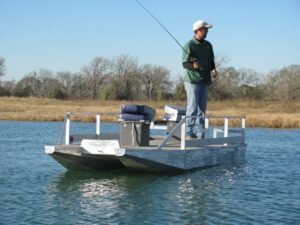Our project with Bassmaster: Will Lake Y become a bass fishing heaven?
By Lochow Ranch
Turning an average, underperforming lake into bass fishing heaven requires some thought, planning and know-how.
Getting those details right is the goal of our new project with Bassmaster, “The Lake Y Project.”
The resulting project is a complete video series, which just aired its first episode at: https://www.bassmaster.com/lakey
The series examines how we tackle Lake Y, an anonymous 56-acre creek-fed lake in Alabama. Bassmaster says Lake Y “could well represent the majority of small lakes and ponds scattered throughout the country.”

In Episode 1, James Hall, editor-in-chief of Bassmaster Magazine, introduces the project with our president, John Jones.
John first studied Lake Y in the spring and did a walkabout, identifying problems and opportunities.
Overall, John says “there are a lot of chances to grow a lot of fish,” but Lake Y also has a lot of problems that need to be addressed.
“Left unmanaged, small fisheries, say from 3 to 100 acres, can get out of balance a lot faster than you would imagine,” Bassmaster explains in its series description.
“Bass can become scarce from predation of other critters, or worse, overpopulate a lake and stunt. Non-desirable species (at least to hardcore bass anglers), like catfish, gar and carp, can create such a biomass in limited space that largemouth simply cannot thrive. Cover and structure can deteriorate, vegetation can choke out open water and water quality can become unbearable for fish in a matter of a few years.”

In the video, John advises that Lake Y owners start an improvement strategy with satellite photos identifying other water body influences and an examination of the lake’s history: when it was built, watershed influences and management approaches. He identified Lake Y as being off color and in a shallow ravine with a small dam.
A lot of people find a great dam site, John explains, but they don’t put money into deepening the lake, which could have cost 10 times as much. But that doesn’t have to be a hindrance, he adds.

His visual assessment also included evidence of otters, and identified issues surrounding the lake’s number and condition of boats, fish feeders and spillway.
It’s a beautiful lake, John says, but multi-owner lakes (as this one appears to be) have to be handled very differently, and multiple ownership could be a help or a hindrance with different priorities. Among many other observations, he also notes the creek could present some challenges with species diversity, and managers should probably come up with a catfish control program.
John notes, “You don’t have to spend a lot of money to have a great lake, but money speeds things up.” He says he asks customers to give him a budget or a timetable for goals. Now that the visual assessment is complete, the next Lake Y episode will focus on its electrofishing survey.
Electrofishing uses an electric current to briefly stun the fish population. This then allows for an accurate assessment of species, size, relative abundance and growth rates of a lake’s fish.
It’s an excellent tool for correcting an out-of-balance pond. Stunted fish or unwanted species can be easily and quickly removed as part of the service. And the survey acts as the reference point for a long-term pond management plan and provides clues for corrective stocking and harvest recommendations.
“In the end, we hope to inspire you to not settle for unimpressive or average fishing, because you can do something about it,” Bassmaster says.
Follow us on Instagram, Facebook or Twitter to see the progress in Lake Y in coming weeks.
Interested in getting your own pond assessment? Get in touch to schedule yours today!
Why Choose Lochow Ranch for Pond & Lake Management
Serving Texas, Oklahoma, Arkansas and Louisiana, Lochow Ranch Pond & Lake Management proudly puts more than two decades of experience to work for you. Our team includes biologists, technicians and other professionals with deep expertise in pond and lake management services.
Check us out if you are considering building a lake, looking for pond stocking services, to buy fish for a pond, or getting professional pond management and maintenance or fishery management. Our services include lake design, pond construction, pond renovation, pond water testing, electrofishing, pond stocking, control of pond weeds, and pond liming and fertilizing. Let us help you build your dream pond that will delight your family and friends for generations to come.





 As we detailed in a
As we detailed in a  Repairs could address obvious signs of wear or just the cleaning of filters and screens. Lochow offers a range of
Repairs could address obvious signs of wear or just the cleaning of filters and screens. Lochow offers a range of 
 Be sure to conduct the necessary annual harvest of predatory fish to ensure that forage populations thrive. It goes without saying that no fishery can sustainably support predation from huge flocks of avian predators without some supplemental stocking from time to time.
Be sure to conduct the necessary annual harvest of predatory fish to ensure that forage populations thrive. It goes without saying that no fishery can sustainably support predation from huge flocks of avian predators without some supplemental stocking from time to time.
 If you can visit your pond multiple times per day, every day, hand feeding will easily accomplish your purposes of feeding the fish.
If you can visit your pond multiple times per day, every day, hand feeding will easily accomplish your purposes of feeding the fish. A few general principles apply: First, feed during daylight hours. Feeding during the day avoids allowing predators to grab a quick meal under the cover of darkness.
A few general principles apply: First, feed during daylight hours. Feeding during the day avoids allowing predators to grab a quick meal under the cover of darkness.

Recent Comments